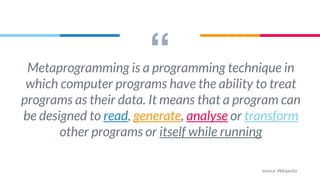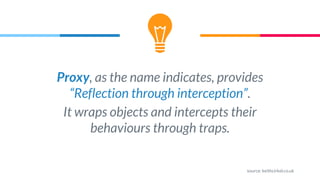Metaprogramming in JavaScript
- 1. Metaprogramming in JavaScript Web Directions Summit | November 17
- 2. Hello! I am Mehdi Valikhani Software Engineer at Autopilot
- 4. “Metaprogramming is a programming technique in which computer programs have the ability to treat programs as their data. It means that a program can be designed to read, generate, analyse or transform other programs or itself while running source: Wikipedia
- 5. “Metaprogramming is a programming technique in which computer programs have the ability to treat programs as their data. It means that a program can be designed to read, generate, analyse or transform other programs or itself while running source: Wikipedia
- 6. Reflection
- 7. “In computer science,reflection is the ability of a computer program to examine,introspect, and modify its own structure and behaviour at runtime. Reflection is a valuable language feature and it facilitates metaprogramming. source: Wikipedia
- 8. Language features that enables reflection 1. Evaluate a string as if it were a source code statement at runtime. 2. Convert a string matching the symbolic name of a class or function into a reference to or invocation of that class or function. 3. Discover and modify source code constructions (such as code blocks, classes, methods, protocols, etc.) as first-class objects at runtime. source: Wikipedia
- 11. Metaprogramming features of ES5 Code Evaluation eval() Examination ➔ instanceof ➔ typeof ➔ Object.getOwnPropertyNames() Modification Getter, setter
- 14. Symbols The new type in JavaScript
- 15. ➔ The seventh type of values in JavaScript Symbol ➔ The Symbol() function returns a value of type symbol ➔ Symbol() always returns unique values ➔ They may be used as an identifier for object properties source: MDN
- 16. Example: Using Symbol as property identifier const nameField = Symbol('beer name'); const beer = { [nameField]: 'VB!' }; console.log(beer[nameField]); // -> VB!
- 17. Example: Using Symbol as property identifier const nameField = Symbol('beer name'); const beer = { [nameField]: 'VB!' }; console.log(beer[nameField]); // -> VB!
- 18. Example: Using Symbol as property identifier const nameField = Symbol('beer name'); const beer = { [nameField]: 'VB!' }; console.log(beer[nameField]); // -> VB!
- 19. Example: Using Symbol as property identifier const nameField = Symbol('beer name'); const beer = { [nameField]: 'VB!' }; console.log(beer[nameField]); // -> VB!
- 20. Well-known Symbols ➔ A set of built-in JavaScript symbols ➔ Represent internal language behaviours ➔ They were not exposed to developers before source: MDN
- 21. Symbols are used by ES6 to enable “Reflection within implementation”. Developers include them on their existing classes and objects to change the default behaviour of an operation or action. source: keithcirkel.co.uk
- 22. What can be done using well-known symbols ➔ Control the behaviour of instanceof for an implemented class ➔ Manipulate the behaviour of for of when iterated over a class ➔ Control over Array.concat ➔ Custom matches for String.match(), String.replace(), String.search() and String.split() ➔ Control the behaviour of Javascript when converting objects to primitive types Check MDN for a list of well-known symbols
- 23. Example: Using well-known Symbol.hasInstance to modify behaviour of “instanceof” class MyArray { } const friends = ['foo', 'bar']; console.log(friends instanceof MyArray); // -> false class MyArray { static [Symbol.hasInstance](object) { return Array.isArray(object); } } const friends = ['foo', 'bar']; console.log(friends instanceof MyArray); // -> true
- 24. Example: Using well-known Symbol.toPrimitive for a ShoppingBasket class class ShoppingBasket { constructor() { this.items = []; } add(title, quantity, price) { this.items.push({ title, quantity, price}); } total() { return this.items.reduce(function(accumulator, item) { return accumulator + (item.price * item.quantity); }, 0); } } } const basket = new ShoppingBasket(); basket.add('bread', 2, 2.5); basket.add('milk', 1, 1.4);
- 25. Example: Using well-known Symbol.toPrimitive for a ShoppingBasket class class ShoppingBasket { constructor() { this.items = []; } add(title, quantity, price) { this.items.push({ title, quantity, price}); } total() { return this.items.reduce(function(accumulator, item) { return accumulator + (item.price * item.quantity); }, 0); } [Symbol.toPrimitive](hint) { if (hint === 'number') return this.total(); return this; } } const basket = new ShoppingBasket(); basket.add('bread', 2, 2.5); basket.add('milk', 1, 1.4); console.log(+basket); // -> 6.4 console.log(new Number(basket)); // -> 6.4
- 26. Example: Using well-known Symbol.toPrimitive for a ShoppingBasket class class ShoppingBasket { constructor() { this.items = []; } add(title, quantity, price) { this.items.push({ title, quantity, price}); } total() { return this.items.reduce(function(accumulator, item) { return accumulator + (item.price * item.quantity); }, 0); } [Symbol.toPrimitive](hint) { if (hint === 'number') return this.total(); return this; } } const basket = new ShoppingBasket(); basket.add('bread', 2, 2.5); basket.add('milk', 1, 1.4); console.log(+basket); // -> 6.4 console.log(new Number(basket)); // -> 6.4
- 27. Proxy
- 28. Proxy, as the name indicates, provides “Reflection through interception”. It wraps objects and intercepts their behaviours through traps. source: keithcirkel.co.uk
- 29. What can be done using Proxy ➔ A trap for delete operator ➔ Manipulate the behaviour of in operator ➔ Control over getting and setting property values ➔ A trap for function calls ➔ A trap for new operator Check MDN for a list of Proxy features
- 30. Example: Implementation of a virtual field using Proxy const student = { firstName: 'Jackson', lastName: 'Rowe', }; const studentProxy = { get: function(object, fieldName) { if (fieldName === 'fullName') { return `${object.firstName} ${object.lastName}`; } return object[fieldName]; } }; const proxiedStudent = new Proxy(student, studentProxy); console.log(proxiedStudent.fullName); // -> Jackson Rowe
- 31. Example: Implementation of a virtual field using Proxy const student = { firstName: 'Jackson', lastName: 'Rowe', }; const studentProxy = { get: function(object, fieldName) { if (fieldName === 'fullName') { return `${object.firstName} ${object.lastName}`; } return object[fieldName]; } }; const proxiedStudent = new Proxy(student, studentProxy); console.log(proxiedStudent.fullName); // -> Jackson Rowe
- 32. Example: Implementation of a virtual field using Proxy const student = { firstName: 'Jackson', lastName: 'Rowe', }; const studentProxy = { get: function(object, fieldName) { if (fieldName === 'fullName') { return `${object.firstName} ${object.lastName}`; } return object[fieldName]; } }; const proxiedStudent = new Proxy(student, studentProxy); console.log(proxiedStudent.fullName); // -> Jackson Rowe
- 33. Example: Implementation of a virtual field using Proxy const student = { firstName: 'Jackson', lastName: 'Rowe', }; const studentProxy = { get: function(object, fieldName) { if (fieldName === 'fullName') { return `${object.firstName} ${object.lastName}`; } return object[fieldName]; } }; const proxiedStudent = new Proxy(student, studentProxy); console.log(proxiedStudent.fullName); // -> Jackson Rowe
- 34. Example: Value validation using Proxy const student = { firstName: 'Jackson', lastName: 'Rowe', }; const studentProxy = { set: function(object, fieldName, value) { // validation logic for the “age” field if (fieldName === 'age') { if (typeof value !== 'number') { throw TypeError('only numbers are accepted'); } if (value <= 0) throw TypeError('that is impossible'); } object[fieldName] = value; return true; } }; const proxiedStudent = new Proxy(student, studentProxy); proxiedStudent.age = 'a'; // errors proxiedStudent.age = -1; // errors proxiedStudent.age = 12; // does not error
- 35. Example: Value validation using Proxy const student = { firstName: 'Jackson', lastName: 'Rowe', }; const studentProxy = { set: function(object, fieldName, value) { // validation logic for the “age” field if (fieldName === 'age') { if (typeof value !== 'number') { throw TypeError('only numbers are accepted'); } if (value <= 0) throw TypeError('that is impossible'); } object[fieldName] = value; return true; } }; const proxiedStudent = new Proxy(student, studentProxy); proxiedStudent.age = 'a'; // errors proxiedStudent.age = -1; // errors proxiedStudent.age = 12; // does not error
- 36. Example: Value validation using Proxy const student = { firstName: 'Jackson', lastName: 'Rowe', }; const studentProxy = { set: function(object, fieldName, value) { // validation logic for the “age” field if (fieldName === 'age') { if (typeof value !== 'number') { throw TypeError('only numbers are accepted'); } if (value <= 0) throw TypeError('that is impossible'); } object[fieldName] = value; return true; } }; const proxiedStudent = new Proxy(student, studentProxy); proxiedStudent.age = 'a'; // errors proxiedStudent.age = -1; // errors proxiedStudent.age = 12; // does not error
- 37. Example: Value validation using Proxy const student = { firstName: 'Jackson', lastName: 'Rowe', }; const studentProxy = { set: function(object, fieldName, value) { // validation logic for the “age” field if (fieldName === 'age') { if (typeof value !== 'number') { throw TypeError('only numbers are accepted'); } if (value <= 0) throw TypeError('that is impossible'); } object[fieldName] = value; return true; } }; const proxiedStudent = new Proxy(student, studentProxy); proxiedStudent.age = 'a'; // errors proxiedStudent.age = -1; // errors proxiedStudent.age = 12; // does not error
- 38. Example: Protect “id” field from deletion using a Proxy const student = { id: 'jackson-rowe', firstName: 'Jackson', lastName: 'Rowe', }; const studentProxy = { deleteProperty: function(object, fieldName) { if (fieldName === 'id') return false; delete object[fieldName]; return true; } }; const proxiedStudent = new Proxy(student, studentProxy); delete proxiedStudent.id // -> false console.log(proxiedStudent.id); // jackson-rowe
- 39. Example: Protect “id” field from deletion using a Proxy const student = { id: 'jackson-rowe', firstName: 'Jackson', lastName: 'Rowe', }; const studentProxy = { deleteProperty: function(object, fieldName) { if (fieldName === 'id') return false; delete object[fieldName]; return true; } }; const proxiedStudent = new Proxy(student, studentProxy); delete proxiedStudent.id // -> false console.log(proxiedStudent.id); // jackson-rowe
- 40. Example: Protect “id” field from deletion using a Proxy const student = { id: 'jackson-rowe', firstName: 'Jackson', lastName: 'Rowe', }; const studentProxy = { deleteProperty: function(object, fieldName) { if (fieldName === 'id') return false; delete object[fieldName]; return true; } }; const proxiedStudent = new Proxy(student, studentProxy); delete proxiedStudent.id // -> false console.log(proxiedStudent.id); // jackson-rowe
- 41. Example: Protect “id” field from deletion using a Proxy const student = { id: 'jackson-rowe', firstName: 'Jackson', lastName: 'Rowe', }; const studentProxy = { deleteProperty: function(object, fieldName) { if (fieldName === 'id') return false; delete object[fieldName]; return true; } }; const proxiedStudent = new Proxy(student, studentProxy); delete proxiedStudent.id // -> false console.log(proxiedStudent.id); // jackson-rowe
- 42. Reflect JavaScript’s new built-in object
- 43. Reflect is all about “Reflection through introspection” - provides API to discover very low level information about code. source: keithcirkel.co.uk
- 44. What can be done using Reflect ➔ Call a function using Reflect.apply() ➔ Define a property using Reflect.defineProperty() ➔ Delete a property using Control over Reflect.deleteProperty() ➔ Get a property value using Reflect.get() ➔ Set property value using Reflect.set() ➔ Check if a property exist using Reflect.has() Check MDN for a list of Reflect features
- 45. What Reflect object offers are either a newer versions of existing methods or entirely new methods - allowing new levels of Reflection within JavaScript. source: keithcirkel.co.uk
- 46. Example: Deleting a property using Reflect.deleteProperty() const student = { firstName: 'Jackson', lastName: 'Rowe', }; console.log(student.firstName); // -> Jackson Reflect.deleteProperty(student, 'firstName'); console.log(student.firstName); // -> undefined
- 47. Example: Deleting a property using Reflect.deleteProperty() const student = { firstName: 'Jackson', lastName: 'Rowe', }; console.log(student.firstName); // -> Jackson Reflect.deleteProperty(student, 'firstName'); console.log(student.firstName); // -> undefined
- 48. Example: Deleting a property using Reflect.deleteProperty() const student = { firstName: 'Jackson', lastName: 'Rowe', }; console.log(student.firstName); // -> Jackson Reflect.deleteProperty(student, 'firstName'); console.log(student.firstName); // -> undefined
- 49. Example: Deleting a property using Reflect.deleteProperty() const student = { firstName: 'Jackson', lastName: 'Rowe', }; console.log(student.firstName); // -> Jackson Reflect.deleteProperty(student, 'firstName'); console.log(student.firstName); // -> undefined
- 50. 100%Modern Browsers (Edge, Firefox, Safari, Chrome) 0%IE 11 100%Node 8 source: http://kangax.github.io/compat-table/es6/ Native support
- 51. Resources ● Wikipedia - Metaprogramming ● Wikipedia - Reflection in Computer Science ● Mozilla - Metaprogramming ● Metaprogramming in ES6 by Keith Cirkel
- 52. Credits Special thanks to all the people who made and released these awesome resources for free: ▷ MDN web docs ▷ Wikipedia and the contributors ▷ Keith Cirkel for the Metaprogramming series ▷ Presentation template by SlidesCarnival
- 53. Thanks! Any questions? You can find me at: ➔ @mehdivk ➔ linkedin.com/in/valikhani/ ➔ [email protected]
















![Example: Using Symbol as property identifier
const nameField = Symbol('beer name');
const beer = {
[nameField]: 'VB!'
};
console.log(beer[nameField]); // -> VB!](https://image.slidesharecdn.com/metaprogramminginjavsscript-171109002427/85/Metaprogramming-in-JavaScript-16-320.jpg)
![Example: Using Symbol as property identifier
const nameField = Symbol('beer name');
const beer = {
[nameField]: 'VB!'
};
console.log(beer[nameField]); // -> VB!](https://image.slidesharecdn.com/metaprogramminginjavsscript-171109002427/85/Metaprogramming-in-JavaScript-17-320.jpg)
![Example: Using Symbol as property identifier
const nameField = Symbol('beer name');
const beer = {
[nameField]: 'VB!'
};
console.log(beer[nameField]); // -> VB!](https://image.slidesharecdn.com/metaprogramminginjavsscript-171109002427/85/Metaprogramming-in-JavaScript-18-320.jpg)
![Example: Using Symbol as property identifier
const nameField = Symbol('beer name');
const beer = {
[nameField]: 'VB!'
};
console.log(beer[nameField]); // -> VB!](https://image.slidesharecdn.com/metaprogramminginjavsscript-171109002427/85/Metaprogramming-in-JavaScript-19-320.jpg)



![Example: Using well-known Symbol.hasInstance to modify behaviour of “instanceof”
class MyArray {
}
const friends = ['foo', 'bar'];
console.log(friends instanceof MyArray); // -> false
class MyArray {
static [Symbol.hasInstance](object) {
return Array.isArray(object);
}
}
const friends = ['foo', 'bar'];
console.log(friends instanceof MyArray); // -> true](https://image.slidesharecdn.com/metaprogramminginjavsscript-171109002427/85/Metaprogramming-in-JavaScript-23-320.jpg)
![Example: Using well-known Symbol.toPrimitive for a ShoppingBasket class
class ShoppingBasket {
constructor() {
this.items = [];
}
add(title, quantity, price) {
this.items.push({ title, quantity, price});
}
total() {
return this.items.reduce(function(accumulator, item) {
return accumulator + (item.price * item.quantity);
}, 0);
}
}
}
const basket = new ShoppingBasket();
basket.add('bread', 2, 2.5);
basket.add('milk', 1, 1.4);](https://image.slidesharecdn.com/metaprogramminginjavsscript-171109002427/85/Metaprogramming-in-JavaScript-24-320.jpg)
![Example: Using well-known Symbol.toPrimitive for a ShoppingBasket class
class ShoppingBasket {
constructor() {
this.items = [];
}
add(title, quantity, price) {
this.items.push({ title, quantity, price});
}
total() {
return this.items.reduce(function(accumulator, item) {
return accumulator + (item.price * item.quantity);
}, 0);
}
[Symbol.toPrimitive](hint) {
if (hint === 'number') return this.total();
return this;
}
}
const basket = new ShoppingBasket();
basket.add('bread', 2, 2.5);
basket.add('milk', 1, 1.4);
console.log(+basket); // -> 6.4
console.log(new Number(basket)); // -> 6.4](https://image.slidesharecdn.com/metaprogramminginjavsscript-171109002427/85/Metaprogramming-in-JavaScript-25-320.jpg)
![Example: Using well-known Symbol.toPrimitive for a ShoppingBasket class
class ShoppingBasket {
constructor() {
this.items = [];
}
add(title, quantity, price) {
this.items.push({ title, quantity, price});
}
total() {
return this.items.reduce(function(accumulator, item) {
return accumulator + (item.price * item.quantity);
}, 0);
}
[Symbol.toPrimitive](hint) {
if (hint === 'number') return this.total();
return this;
}
}
const basket = new ShoppingBasket();
basket.add('bread', 2, 2.5);
basket.add('milk', 1, 1.4);
console.log(+basket); // -> 6.4
console.log(new Number(basket)); // -> 6.4](https://image.slidesharecdn.com/metaprogramminginjavsscript-171109002427/85/Metaprogramming-in-JavaScript-26-320.jpg)



![Example: Implementation of a virtual field using Proxy
const student = {
firstName: 'Jackson',
lastName: 'Rowe',
};
const studentProxy = {
get: function(object, fieldName) {
if (fieldName === 'fullName') {
return `${object.firstName} ${object.lastName}`;
}
return object[fieldName];
}
};
const proxiedStudent = new Proxy(student, studentProxy);
console.log(proxiedStudent.fullName); // -> Jackson Rowe](https://image.slidesharecdn.com/metaprogramminginjavsscript-171109002427/85/Metaprogramming-in-JavaScript-30-320.jpg)
![Example: Implementation of a virtual field using Proxy
const student = {
firstName: 'Jackson',
lastName: 'Rowe',
};
const studentProxy = {
get: function(object, fieldName) {
if (fieldName === 'fullName') {
return `${object.firstName} ${object.lastName}`;
}
return object[fieldName];
}
};
const proxiedStudent = new Proxy(student, studentProxy);
console.log(proxiedStudent.fullName); // -> Jackson Rowe](https://image.slidesharecdn.com/metaprogramminginjavsscript-171109002427/85/Metaprogramming-in-JavaScript-31-320.jpg)
![Example: Implementation of a virtual field using Proxy
const student = {
firstName: 'Jackson',
lastName: 'Rowe',
};
const studentProxy = {
get: function(object, fieldName) {
if (fieldName === 'fullName') {
return `${object.firstName} ${object.lastName}`;
}
return object[fieldName];
}
};
const proxiedStudent = new Proxy(student, studentProxy);
console.log(proxiedStudent.fullName); // -> Jackson Rowe](https://image.slidesharecdn.com/metaprogramminginjavsscript-171109002427/85/Metaprogramming-in-JavaScript-32-320.jpg)
![Example: Implementation of a virtual field using Proxy
const student = {
firstName: 'Jackson',
lastName: 'Rowe',
};
const studentProxy = {
get: function(object, fieldName) {
if (fieldName === 'fullName') {
return `${object.firstName} ${object.lastName}`;
}
return object[fieldName];
}
};
const proxiedStudent = new Proxy(student, studentProxy);
console.log(proxiedStudent.fullName); // -> Jackson Rowe](https://image.slidesharecdn.com/metaprogramminginjavsscript-171109002427/85/Metaprogramming-in-JavaScript-33-320.jpg)
![Example: Value validation using Proxy
const student = {
firstName: 'Jackson',
lastName: 'Rowe',
};
const studentProxy = {
set: function(object, fieldName, value) {
// validation logic for the “age” field
if (fieldName === 'age') {
if (typeof value !== 'number') {
throw TypeError('only numbers are accepted');
}
if (value <= 0) throw TypeError('that is impossible');
}
object[fieldName] = value;
return true;
}
};
const proxiedStudent = new Proxy(student, studentProxy);
proxiedStudent.age = 'a'; // errors
proxiedStudent.age = -1; // errors
proxiedStudent.age = 12; // does not error](https://image.slidesharecdn.com/metaprogramminginjavsscript-171109002427/85/Metaprogramming-in-JavaScript-34-320.jpg)
![Example: Value validation using Proxy
const student = {
firstName: 'Jackson',
lastName: 'Rowe',
};
const studentProxy = {
set: function(object, fieldName, value) {
// validation logic for the “age” field
if (fieldName === 'age') {
if (typeof value !== 'number') {
throw TypeError('only numbers are accepted');
}
if (value <= 0) throw TypeError('that is impossible');
}
object[fieldName] = value;
return true;
}
};
const proxiedStudent = new Proxy(student, studentProxy);
proxiedStudent.age = 'a'; // errors
proxiedStudent.age = -1; // errors
proxiedStudent.age = 12; // does not error](https://image.slidesharecdn.com/metaprogramminginjavsscript-171109002427/85/Metaprogramming-in-JavaScript-35-320.jpg)
![Example: Value validation using Proxy
const student = {
firstName: 'Jackson',
lastName: 'Rowe',
};
const studentProxy = {
set: function(object, fieldName, value) {
// validation logic for the “age” field
if (fieldName === 'age') {
if (typeof value !== 'number') {
throw TypeError('only numbers are accepted');
}
if (value <= 0) throw TypeError('that is impossible');
}
object[fieldName] = value;
return true;
}
};
const proxiedStudent = new Proxy(student, studentProxy);
proxiedStudent.age = 'a'; // errors
proxiedStudent.age = -1; // errors
proxiedStudent.age = 12; // does not error](https://image.slidesharecdn.com/metaprogramminginjavsscript-171109002427/85/Metaprogramming-in-JavaScript-36-320.jpg)
![Example: Value validation using Proxy
const student = {
firstName: 'Jackson',
lastName: 'Rowe',
};
const studentProxy = {
set: function(object, fieldName, value) {
// validation logic for the “age” field
if (fieldName === 'age') {
if (typeof value !== 'number') {
throw TypeError('only numbers are accepted');
}
if (value <= 0) throw TypeError('that is impossible');
}
object[fieldName] = value;
return true;
}
};
const proxiedStudent = new Proxy(student, studentProxy);
proxiedStudent.age = 'a'; // errors
proxiedStudent.age = -1; // errors
proxiedStudent.age = 12; // does not error](https://image.slidesharecdn.com/metaprogramminginjavsscript-171109002427/85/Metaprogramming-in-JavaScript-37-320.jpg)
![Example: Protect “id” field from deletion using a Proxy
const student = {
id: 'jackson-rowe',
firstName: 'Jackson',
lastName: 'Rowe',
};
const studentProxy = {
deleteProperty: function(object, fieldName) {
if (fieldName === 'id') return false;
delete object[fieldName];
return true;
}
};
const proxiedStudent = new Proxy(student, studentProxy);
delete proxiedStudent.id // -> false
console.log(proxiedStudent.id); // jackson-rowe](https://image.slidesharecdn.com/metaprogramminginjavsscript-171109002427/85/Metaprogramming-in-JavaScript-38-320.jpg)
![Example: Protect “id” field from deletion using a Proxy
const student = {
id: 'jackson-rowe',
firstName: 'Jackson',
lastName: 'Rowe',
};
const studentProxy = {
deleteProperty: function(object, fieldName) {
if (fieldName === 'id') return false;
delete object[fieldName];
return true;
}
};
const proxiedStudent = new Proxy(student, studentProxy);
delete proxiedStudent.id // -> false
console.log(proxiedStudent.id); // jackson-rowe](https://image.slidesharecdn.com/metaprogramminginjavsscript-171109002427/85/Metaprogramming-in-JavaScript-39-320.jpg)
![Example: Protect “id” field from deletion using a Proxy
const student = {
id: 'jackson-rowe',
firstName: 'Jackson',
lastName: 'Rowe',
};
const studentProxy = {
deleteProperty: function(object, fieldName) {
if (fieldName === 'id') return false;
delete object[fieldName];
return true;
}
};
const proxiedStudent = new Proxy(student, studentProxy);
delete proxiedStudent.id // -> false
console.log(proxiedStudent.id); // jackson-rowe](https://image.slidesharecdn.com/metaprogramminginjavsscript-171109002427/85/Metaprogramming-in-JavaScript-40-320.jpg)
![Example: Protect “id” field from deletion using a Proxy
const student = {
id: 'jackson-rowe',
firstName: 'Jackson',
lastName: 'Rowe',
};
const studentProxy = {
deleteProperty: function(object, fieldName) {
if (fieldName === 'id') return false;
delete object[fieldName];
return true;
}
};
const proxiedStudent = new Proxy(student, studentProxy);
delete proxiedStudent.id // -> false
console.log(proxiedStudent.id); // jackson-rowe](https://image.slidesharecdn.com/metaprogramminginjavsscript-171109002427/85/Metaprogramming-in-JavaScript-41-320.jpg)











